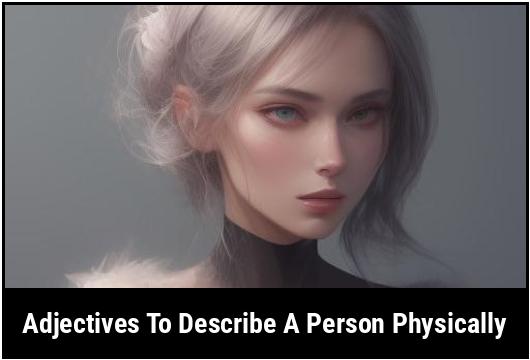
41 Adjectives To Describe A Person Physically
When describing a person, it’s essential to paint a vivid picture not only of their personality and character but also their physical appearance. Utilizing adjectives to describe a person physically can help create a detailed and accurate depiction of an individual’s appearance. From their hair color to their body shape, these adjectives provide a comprehensive insight into how a person looks. This article explores the importance of using adjectives to describe a person physically, offers guidance on selecting the right adjectives, and delves into the various types of adjectives suitable for this purpose.
Key Takeaways
- Adjectives play a crucial role in delineating a person’s physical attributes, adding depth and specificity to the description.
- A well-chosen physical adjective can evoke a clear mental image of a person’s appearance.
- When selecting physical adjectives, it’s essential to consider accuracy, sensitivity, and cultural connotations.
Adjectives To Describe A Person Physically
1. Radiant
This adjective encapsulates the beauty and glowing nature of someone’s appearance.
2. Alluring
An alluring person possesses a captivating and irresistible charm.
3. Striking
This describes someone who stands out in a crowd due to their unique and eye-catching features.
4. Dashing
An adjective often used to depict someone who is stylish, elegant, and has a confident demeanor.
5. Athletic
This term signifies a person with a well-toned, fit physique.
6. Petite
Used to describe someone who is delicately small and slender.
7. Statuesque
This word characterizes a person with an impressive and majestic physical presence.
8. Charming
A charming individual has an appealing aura and captivating personality.
9. Rugged
Rugged individuals possess a rough yet attractive physical appearance.
10. Delicate
This adjective describes someone with a fragile and graceful appearance.
11. Energetic
Energetic individuals are lively, vibrant, and full of life.
12. Elegant
This term is reserved for those who display grace, poise, and timeless beauty.
13. Magnetic
Used to portray someone who has an irresistible and attractive personality.
14. Well-groomed
This adjective describes someone who takes meticulous care of their appearance.
15. Spirited
Spirited individuals possess an animated, lively, and enthusiastic demeanor.
16. Chiseled
Chiseled individuals have a sharply defined and sculpted physique.
17. Vivacious
This word portrays someone who is lively, animated, and full of energy.
18. Graceful
Graceful individuals move and carry themselves in a refined and elegant manner.
19. Svelte
This term describes someone with a slender, graceful figure.
20. Enchanting
An enchanting person possesses a magical and captivating attractiveness.
21. Robust
Used to describe someone with a strong and sturdy physical build.
22. Symmetrical
This adjective highlights an individual with well-proportioned and balanced features.
23. Exquisite
Exquisite describes someone with an incredibly beautiful, delicate appearance.
24. Majestic
Majestic individuals possess a dignified and awe-inspiring presence.
25. Breathtaking
Used to capture the sheer beauty and awe-inspiring nature of someone’s appearance.
26. Curvaceous
Curvaceous individuals have voluptuous and shapely figures.
27. Polished
This adjective characterizes someone who always appears well put-together and refined.
28. Distinguished
Distinguished individuals possess an air of respectability, elegance, and wisdom.
29. Balanced
Balanced describes someone with a harmonious and proportionate physique.
30. Adorable
Used to describe someone with a lovable, cute, and endearing appearance.
31. Youthful
Youthful individuals have an appearance that is fresh, young, and full of vitality.
32. Exotic
An exotic person possesses distinctive and intriguing features that are not common to the observer’s culture.
33. Robust
Robust individuals have a strong and sturdy physique.
34. Glowing
This adjective signifies a person who radiates a healthy and vibrant aura.
35. Polished
Polished individuals always maintain a sophisticated and refined appearance.
36. Harmonious
Harmonious describes someone with features that complement each other seamlessly.
37. Endearing
Used to describe someone with a persona that elicits fondness and affection.
38. Mysterious
A mysterious person possesses an enigmatic and intriguing physical presence.
39. Magnetic
Magnetic individuals have a captivating and irresistible charm.
40. Well-built
Well-built people have a strong, well-developed physique.
41. Unique
Unique signifies someone with distinctive and one-of-a-kind physical attributes.
Why Use Adjectives To Describe A Person Physically
The use of adjectives to describe a person physically serves multiple crucial purposes. It allows the speaker or writer to convey a precise and vivid mental image of the person to the audience. This aids in clear communication and enables the audience to form a mental picture that closely aligns with the individual being described.
Moreover, physical adjectives can be utilized for literary or creative purposes, enriching the storytelling or descriptive process. For instance, in literature, the employment of descriptive physical adjectives can bring characters to life, fostering a deeper connection between the reader and the story’s protagonists.
Additionally, employing adjectives to describe a person physically can be advantageous in a variety of scenarios, such as creating more engaging and compelling dating profiles, crafting professional biographies, or providing detailed witness descriptions in a police report. In all of these instances, selecting the right physical adjectives allows for more effective and accurate communication.
How To Choose The Right Adjective To Describe A Person Physically
Selecting the appropriate adjectives to describe a person physically requires careful consideration. When choosing these adjectives, it’s crucial to prioritize accuracy, sensitivity, and cultural context.
First and foremost, accuracy is paramount. The chosen adjectives should accurately reflect the person’s physical appearance, ensuring that the description is precise and reliable. It’s essential to observe the details attentively and select adjectives that capture the nuances of the person’s physical attributes.
Sensitivity is another critical factor to consider. When describing a person physically, it’s imperative to be mindful of the impact of the chosen adjectives. Avoiding adjectives that may come across as insensitive or offensive is essential. Adjectives should be chosen with respect and consideration for the individual being described.
Cultural connotations also play a significant role in the selection of physical adjectives. Certain adjectives may hold different meanings or connotations in various cultural contexts. Therefore, it’s essential to be aware of these nuances and select adjectives that are culturally appropriate and respectful.
Types Of Adjectives For Describing A Person Physically
When describing a person physically, various types of adjectives can be employed. These adjectives encompass a wide range of physical attributes, providing a comprehensive toolkit for depicting an individual’s appearance.
1. Descriptive Adjectives
Descriptive adjectives are fundamental in communicating the physical characteristics of a person. These adjectives vividly portray specific features such as height, weight, hair color, eye color, skin tone, and facial features. They serve to create a detailed and accurate visual representation of the person being described.
Example:
- Tall, petite, muscular, slender, plump
- Blond, brunette, red-haired
- Blue-eyed, green-eyed, almond-eyed
- Fair-skinned, olive-skinned, dark-skinned
- Oval-faced, angular-jawed, freckled
2. Age-related Adjectives
Adjectives related to age can be employed to describe a person’s physical appearance in terms of their age, whether youthful, mature, or elderly. These adjectives help in providing a clear understanding of the individual’s age-related physical characteristics.
Example:
- Youthful, middle-aged, elderly
- Baby-faced, wrinkled, graying
3. Physiological Adjectives
Physiological adjectives can be used to convey specific physiological attributes of a person, such as their posture, gait, or physical condition. These adjectives offer a deeper insight into an individual’s physicality beyond their basic features.
Example:
- Slouching, upright, athletic
- Limping, brisk, hunched
4. Adjectives For Facial Expressions
Adjectives related to facial expressions play a crucial role in delineating a person’s countenance and emotions. These adjectives can provide insight into the individual’s appearance by describing their facial expressions and overall demeanor.
Example:
- Cheerful, somber, stern
- Smiling, frowning, scowling
5. Style-related Adjectives
Adjectives related to personal style and appearance provide a glimpse into an individual’s fashion sense, grooming, and overall presentation. These adjectives add depth to the description by encapsulating the person’s style choices and overall presentation.
Example:
- Stylish, elegant, flamboyant
- Casual, trendy, sophisticated
- Well-groomed, disheveled, unkempt
6. Adjectives For Body Shape
Describing a person’s body shape is essential for crafting a comprehensive physical depiction. Adjectives pertaining to body shape aid in conveying the overall structure and contours of an individual’s physique.
Example:
- Hourglass, pear-shaped, athletic, stocky
- Lean, curvaceous, muscular
The use of adjectives to describe a person physically is instrumental in communicating detailed and vivid representations of individuals. These adjectives enable the creation of precise mental images, enrich storytelling, and enhance communication. When selecting physical adjectives, it’s crucial to prioritize accuracy, sensitivity, and cultural context, ensuring that the chosen adjectives accurately and respectfully depict the person’s physical attributes. By delving into the various types of adjectives suitable for describing a person physically, individuals can effectively communicate and convey a comprehensive understanding of an individual’s appearance.
Examples Of Adjectives For Different Types Of Persons Physically
When it comes to describing a person physically, adjectives play a crucial role in painting a vivid picture in the reader’s mind. Adjectives help us convey specific details about a person’s appearance, enabling us to capture their physical features, characteristics, and overall presence. Whether you are writing a character description, describing someone in a story, or simply trying to capture someone’s essence in words, knowing the right adjectives can make a significant difference.
Height
- Tall: A person who is above average height, towering over others in a crowd.
- Short: A person who is below average height, typically standing shorter than most people.
- Petite: A person who is small and delicately built, often used to describe women.
- Stature: Refers to a person’s overall height and build.
- Lanky: Describes someone who is tall and thin, with long limbs.
- Compact: Describes someone who is short and has a well-proportioned body.
Weight
- Slim: A person who has a slender and lean body.
- Thin: A person who has a small amount of body fat and a delicate frame.
- Plump: A person who is pleasantly round or slightly overweight.
- Obese: Describes someone who is excessively overweight and carries a significant amount of body fat.
- Athletic: Refers to a person who has a fit and muscular physique.
- Stout: Describes a person who is broad and solidly built, often implying a certain level of heaviness.
Facial Features
- Beautiful: Describes a person with aesthetically pleasing facial features.
- Attractive: Refers to someone who is pleasing to look at due to their facial features.
- Handsome: Used to describe a man who is physically pleasing, usually with strong and masculine features.
- Gorgeous: Indicates someone who is exceptionally beautiful or stunning.
- Cute: Describes a person with endearing or charming facial features.
- Plain: Refers to a person with unremarkable or average facial features.
Hair
- Straight: Describes hair that is not curly or wavy, but falls in a smooth and sleek manner.
- Curly: Refers to hair that forms spirals or coils.
- Wavy: Describes hair that has gentle curves or waves.
- Bald: Indicates the absence of hair on the head.
- Long: Refers to hair that extends below the shoulders.
- Short: Describes hair that is cut or styled above the shoulders.
Body Types
- Slim: A person with a slender and well-proportioned body.
- Muscular: Describes someone with well-defined and developed muscles.
- Athletic: Refers to a person who is physically fit and possesses a combination of muscularity and leanness.
- Curvy: Describes a person with well-defined curves, often implying a full bust, waist, and hips.
- Petite: A person who is short and has a small, delicate frame.
- Stocky: Refers to a person with a compact and solidly built body, often implying a sturdy physique.
These examples provide a glimpse into the wide array of adjectives that can be used to describe a person physically. It is essential to choose adjectives based on their appropriateness and the effect you want to achieve in your writing.
Common Mistakes In Using Adjectives To Describe Person Physically
While using adjectives to describe a person physically can enhance your writing, it is crucial to avoid common mistakes that can hinder the impact of your descriptions. Here are some pitfalls to watch out for:
1. Generalization
Avoid using generic adjectives that do not provide specific details about the person’s physical appearance. For example, using adjectives like "nice," "fine," or "pretty" does not give the reader a clear picture.
Instead of saying "She was pretty," you can describe the person more vividly by saying, "She had delicate features, with a slender nose and almond-shaped eyes that sparkled."
2. Overuse
While adjectives can enrich your descriptions, using too many can overwhelm the reader. It is essential to strike a balance and focus on the most impactful and relevant adjectives. Overusing adjectives can also make your writing appear exaggerated or unrealistic.
For example, saying, "He had piercing, intense, and mesmerizing eyes that captivated everyone who looked at him," can seem excessive. Instead, you could choose the most appropriate and impactful adjective, such as "mesmerizing."
3. Lack Of Precision
To create a vivid image in the reader’s mind, it is crucial to be precise and specific with your adjectives. Vague or nonspecific descriptions can leave the reader confused or unsure about the person’s physical appearance.
Instead of saying, "She had nice hair," you could provide more precise details like, "Her long, flowing chestnut locks cascaded down her back, swaying with every step she took."
4. Lack Of Variation
Using the same adjectives repeatedly can make your writing monotonous and predictable. It is important to vary your word choice to keep your descriptions engaging and fresh.
Instead of repeatedly using "beautiful," consider using synonyms like "stunning," "gorgeous," or "radiant" to provide variety and enhance your descriptions.
5. Ignoring Other Senses
While physical appearance is primarily about visual descriptions, incorporating other senses can enrich your writing. Consider using adjectives that appeal to other senses, such as touch (smooth, rough), smell (fragrant, musky), or sound (gentle, booming).
By incorporating these senses, you can create a more immersive and vivid experience for the reader.
What Is The Difference Between "lean" And "skinny" As Adjectives To Describe A Person Physically?
"Lean" typically implies a strong and athletic build with toned muscles, while "skinny" can have a negative connotation and suggests a very thin and fragile physique.
How Is The Adjective "chubby" Different From "overweight"?
"Chubby" generally describes a person who is slightly overweight with a round and plump appearance, while "overweight" refers to someone who exceeds the recommended weight for their height and may have a higher body mass index.
Can "voluptuous" And "curvy" Be Used Interchangeably To Describe A Person’s Body Shape?
While both adjectives imply a full and shapely figure, "voluptuous" may suggest a more sensual or seductive appeal, while "curvy" can encompass a wider range of body types and may not necessarily have a sexual connotation.
What Does It Mean When Someone Is Described As "petite"?
"Petite" is typically used to describe a person who is short in stature and has a small and delicate build. It can also refer to clothing sizes designed for women with smaller frames.
How Is "tall" Different From "heightened" As Adjectives To Describe A Person’s Height?
"Tall" is a straightforward description of someone who is above average height, while "heightened" can suggest a sense of pride or superiority in one’s tall stature, or could also refer to someone who is standing or sitting in a more upright or elongated position to appear taller.








